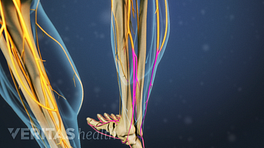Prescription foot orthotics usually have a component called a rear foot post, which most prefabricated (over-the-counter, or non-prescription) foot orthotics do not have. A rear foot post is a wedge that tapers outward underneath the heel. This part of the orthotic is usually customized for the individual wearer’s unique feet.
See Foot Pain Causes and Treatments
The rear foot post wedge will cant, or shift, the ankles outward and back to their correct position underneath the shin bone. This shift in turn theoretically helps reduce the pronation of the ankle and subsequent abnormal placement of the knees and hips (genu valgus and coxa vara, respectively), thereby stabilizing the pelvis.
A more stable pelvis helps provide more support and stability to the lower back—which often reduces low back pain.
See Foot Orthotics for Chronic Low Back Pain
Clinical Effectiveness of Prefabricated vs. Prescription
Several studies that have compared the results from using prefabricated versus customized prescription foot orthotics.1
For example, a 1998 study published in the Journal of the American Podiatric Medical Association found that both types were helpful in initially improving “gait economy,” but also reported that the beneficial effects lasted longer in the customized orthotic group. The study also found that gait economy deteriorated after four weeks in the prefabricated foot orthotic group.
However, a similar study published in 2009 reported that there was no significant difference when comparing prefabricated vs. custom made foot orthotics. This study compared both prefabricated and customized orthotics with a placebo, or “sham” orthotic, concluding that custom-made foot orthoses modestly helped reduce foot pain from pes cavus (high arch), arthritis, plantar fasciitis, and painful hallux valgus. In addition, the study concluded that there was no evidence that custom shoe insoles were more effective than prefabricated ones.2
References
- 1.Trotter LC, Pierrynowski MR. Changes in gait economy between full-contact custom-made foot orthoses and prefabricated inserts in patients with musculoskeletal pain: a randomized clinical trial.J Am Podiatr Med Assoc. 2008 Nov-Dec; 98(6):429-35.
- 2.Kripke C. Custom vs. prefabricated orthoses for foot pain. Am Fam Physician. 2009 May 1;79(9):758-9.






